C major scale: C D E F G A B. Seven notes makes it a heptonic scale. There are other heptonic scales that are not major scales.
The pitch steps in a major scale from the tonic is whole step, whole step, half step, whole step, whole step, whole step, then half step. (whole whole half, whole whole whole half). This sequence of pitch intervals defines the sound of a major scale. You can start on any note, and play the sequence of pitch intervals for a major scale. Just remember, whole whole half, whole whole whole half (1, 1, 1/2, 1, 1, 1, 1/2).
Major scales (The tonic note is the first note and name of the major scale)
C D E F G A B (C major scale)
C# D# E# F# G# A# B# (C# major scale)
Cb Db Eb Fb Gb Ab Bb (Cb major scale)
D E F# G A B C# (D major scale)
Db Eb F Gb Ab Bb C
E F# G# A B C# D#
Eb F G Ab Bb C D
F G A Bb C D E
F# G# A# B C# D# E#
G A B C D E F#
Gb Ab Bb Cb Db Eb F
A B C# D E F# G#
Ab Bb C Db Eb F G
B C# D# E F# G# A#
Bb C D Eb F G A
Notice there are 15 scales shown above, but three of these share the same pitches. C# has the same pitches as Db, Cb the same as B, and Gb the same as F#.
Also, notice that you can arrange the scales by the number of flats and sharps in each scale.
(7 flats) Cb Db Eb Fb Gb Ab Bb
(6 flats) Gb Ab Bb Cb Db Eb F
(5 flats) Db Eb F Gb Ab Bb C
(4 flats) Ab Bb C Db Eb F G
(3 flats) Eb F G Ab Bb C D
(2 flats) Bb C D Eb F G A
(1 flat) F G A Bb C D E
C D E F G A B
(1 sharp) G A B C D E F# G
(2 sharps) D E F# G A B C#
(3 sharps) A B C# D E F# G#
(4 sharps) E F# G# A B C# D#
(5 sharps) B C# D# E F# G# A#
(6 sharps) F# G# A# B C# D# E#
(7 sharps) C# D# E# F# G# A# B#
In addition, you can arrange these scales by their tonic notes so that they repeat themselves like going around in a circle.
C > F > Bb > Eb > Ab > Db > Gb
Gb is the same pitch as F#, so then F# > B > E > A > D > G > C
This circle is called the circle of fourths and fifths because each pitch in the sequence is a fourth step up from the previous note, or a fifth step up from the previous note. Consider each ‘previous’ note the tonic. For example, C > F > Bb > Eb and so on progress to the next higher pitch in fourths. And Eb > Bb > F > C progress to the next higher pitch in fifths.
Playing progressively through the tonics on the circle of fourths and fifths is a good way to learn the fourth and fifth note in each scale.
Also, playing the scale for each tonic as you progress around the circle is a great way to begin learning chord progressions.

